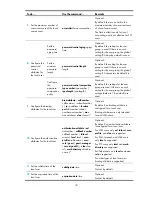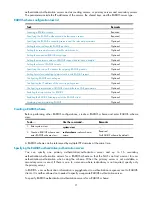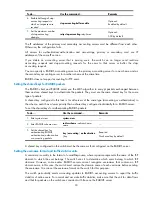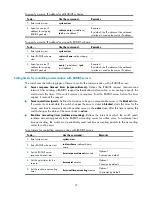
21
authentication/authorization servers and accounting servers, or primary servers and secondary servers.
The parameters include the IP addresses of the servers, the shared keys, and the RADIUS server type.
RADIUS scheme configuration task list
Task Remarks
Required
Specifying the RADIUS authentication/authorization servers
Required
Specifying the RADIUS accounting servers and the relevant parameters
Optional
Setting the shared keys for RADIUS packets
Optional
Setting the username format and traffic statistics units
Optional
Setting the supported RADIUS server type
Optional
Setting the maximum number of RADIUS request transmission attempts
Optional
Setting the status of RADIUS servers
Optional
Specifying the source IP address for outgoing RADIUS packets
Optional
Setting timers for controlling communication with RADIUS servers
Optional
Configuring RADIUS accounting-on
Optional
Configuring the IP address of the security policy server
Optional
Configuring interpretation of RADIUS class attribute as CAR parameters
Optional
Enabling the trap function for RADIUS
Optional
Enabling the RADIUS listening port of the RADIUS client
Optional
Displaying and maintaining RADIUS
Optional
Creating a RADIUS scheme
Before performing other RADIUS configurations, create a RADIUS scheme and enter RADIUS scheme
view:
To do…
Use the command…
Remarks
1.
Enter system view.
system-view
—
2.
Create a RADIUS scheme and
enter RADIUS scheme view.
radius scheme
radius-scheme-
name
Required
No RADIUS scheme by default
A RADIUS scheme can be referenced by multiple ISP domains at the same time.
Specifying the RADIUS authentication/authorization servers
You can specify one primary authentication/authorization server and up to 16 secondary
authentication/authorization servers for a RADIUS scheme so that the NAS can find a server for user
authentication/authorization when using the scheme. When the primary server is not available, a
secondary server is used, if there is one. In a scenario where redundancy is not required, specify only
the primary server.
In RADIUS, user authorization information is piggybacked in authentication responses sent to RADIUS
clients. It is neither allowed nor needed to specify a separate RADIUS authorization server.
To specify RADIUS authentication/authorization servers for a RADIUS scheme:
Содержание A5830 Series
Страница 207: ...199 Figure 62 SFTP client interface ...
















































